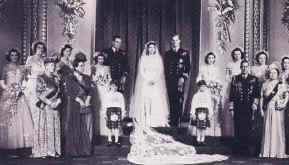In the interests of posterity it might have been wiser to have used satin from another source, since the fabric used is quite rotted. At an interview in the London Museum in 1978, Miss Kay Staniland, Keeper of the Robes, told me that the Queen's wedding dress, which has been displayed several times, was in an appalling condition; the main problem being the silk used for the dress. Miss Staniland described the silk as being very heavily tin weighted. She explained that the tin weighting was contributing to the continual deterioration of the fabric, speeding up the rotting process which starts as soon as any fabric is removed from the loom.
In the early 1970s, the dress was displayed with half a dozen other Royal wedding dresses. When Miss Staniland attempted to fit the Queen's dress to its polystyrene dress form she found that the weight of the embroidery dragged the skirt down, increasing the strain on the weave. To have left the dress on the form as it was, would have resulted in the skirt tearing from the bodice. The problem was solved by the construction of a calico skirt with tapes. This was used to support the heavy embroidered skirt and was secured to the form, without adding strain to the bodice.
Despite the fact that I was a serious costume student I was not allowed to even see, let alone handle the gown using special conservation gloves. However Miss Staniland kindly went to some trouble to show me photographs of the back view of the dress. The back fastening of the dress was not a zip, but a series of fourteen tiny covered buttons which were spaced closely together and stopped at the base of the spine. All the buttonholes had unravelled and beneath these there was a zip for additional support.
The left sleeve was badly frayed; the head having come completely away from the armhole, revealing a tear in the armpit. Some of the underarm degradation of the fabric was due probably to the combination of the metal salts in the silk and underarm perspiration which together speeded up the disintegration process. Anyone standing under intense camera lights knowing they would be watched by millions combined with the occasion of a marriage ceremony would perspire a great deal.
The keeper confided that gowns of this type were a nightmare to display and handle and from the Museum's point of view, the condition of this comparatively new dress was classified as poor. Already it was a conservation problem limiting the length of time it could be displayed even in the most carefully controlled conditions. Considering I was given that information a quarter of a century ago one can only speculate at the condition of the gown today. You are reading an original 'Queen's Wedding Dress' royalty fashion history article by Pauline Weston Thomas at
In the early 1970s, the dress was displayed with half a dozen other Royal wedding dresses. When Miss Staniland attempted to fit the Queen's dress to its polystyrene dress form she found that the weight of the embroidery dragged the skirt down, increasing the strain on the weave. To have left the dress on the form as it was, would have resulted in the skirt tearing from the bodice. The problem was solved by the construction of a calico skirt with tapes. This was used to support the heavy embroidered skirt and was secured to the form, without adding strain to the bodice.
Despite the fact that I was a serious costume student I was not allowed to even see, let alone handle the gown using special conservation gloves. However Miss Staniland kindly went to some trouble to show me photographs of the back view of the dress. The back fastening of the dress was not a zip, but a series of fourteen tiny covered buttons which were spaced closely together and stopped at the base of the spine. All the buttonholes had unravelled and beneath these there was a zip for additional support.
The left sleeve was badly frayed; the head having come completely away from the armhole, revealing a tear in the armpit. Some of the underarm degradation of the fabric was due probably to the combination of the metal salts in the silk and underarm perspiration which together speeded up the disintegration process. Anyone standing under intense camera lights knowing they would be watched by millions combined with the occasion of a marriage ceremony would perspire a great deal.
The keeper confided that gowns of this type were a nightmare to display and handle and from the Museum's point of view, the condition of this comparatively new dress was classified as poor. Already it was a conservation problem limiting the length of time it could be displayed even in the most carefully controlled conditions. Considering I was given that information a quarter of a century ago one can only speculate at the condition of the gown today. You are reading an original 'Queen's Wedding Dress' royalty fashion history article by Pauline Weston Thomas at







